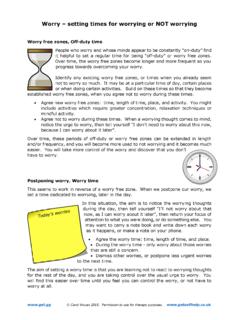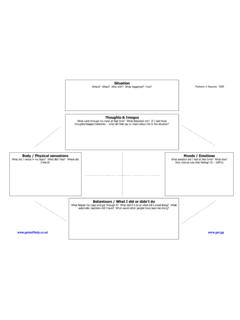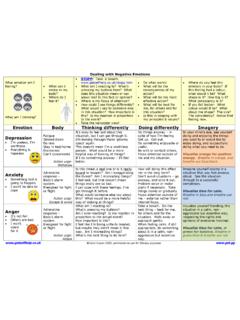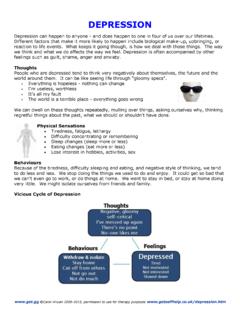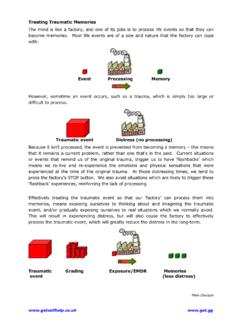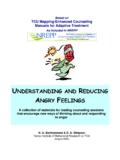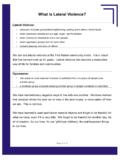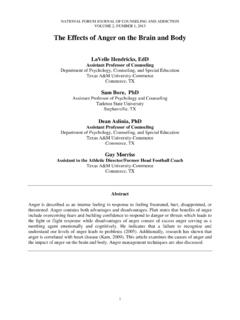Transcription of SELF HELP FOR ANGER
1 Carol Vivyan 2009-15, permission to use for therapy purposes self help FOR ANGER ANGER is a normal reaction and emotion. It can be very helpful as it motivates us to do something to right an injustice! It can also lead us into problems. ANGER is a result of thinking that we have been unfairly treated or disrespected, or that we or others have broken or fallen short of our rules, expectations, and we won't stand for it. It is helpful to understand what is driving our ANGER , which is often related to events in our past. Current situations can FEEL the same, so it triggers our ANGER response. Thinking this way leads us to feel angry, which stimulates the body's adrenaline response which is our body's way of helping us to cope with either fighting, or running away ('fight or flight' response).
2 We respond to those thoughts and feelings, by acting, or feeling an urge to act, in threatening or aggressive ways. Thoughts that often occur: I'm being treated unfairly I'm being disrespected They're breaking a rule or standard I won't stand for it I must do something about it! Physical Sensations - The Adrenaline Response When there is real, or we believe there is a real, threat or danger, or that we have to defend or stand up for what we believe is right, our bodies' automatic survival mechanism kicks in very quickly. This helps energise us to fight or run away ('fight or flight response'). We will notice lots of physical sensations, which might include: heart racing or pounding - enabling good blood supply around our bodies breathing quickly - allowing more oxygen around the body tense muscles - a state of readiness to fight or flee shaking hot, sweating light-headed stomach churning or butterflies fist or teeth clenching Behaviours might include.
3 Staring & angry facial expression aggressive body posture go towards what makes us angry attacking or arguing hitting out (or urge to hit out) shouting, snapping at others running or storming away staying silent, inwardly seething door slamming, making lots of noise sulking or being sarcastic We all feel angry some times. ANGER has consequences, and they often involve hurting other people - more usually their feelings, but sometimes physically. ANGER can cause problems in our personal lives, and affect work and study. After an angry outburst, we can think very critically of ourselves and our actions, leading us to feel guilty, ashamed and lower our mood, which might result in our withdrawing from others, not wanting to do anything (see depression self help ).
4 Vicious Cogs of ANGER We can identify what keeps the ANGER problem going the cogs of ANGER . Then we can make positive and helpful changes in each of these cogs to reduce the ANGER and effective deal with situations in spite of feeling angry. Carol Vivyan 2009-15, permission to use for therapy purposes Example of vicious cycle of ANGER Identify your triggers What or when are the times when you are more likely to get angry? If you can see the patterns, then you can do something about those situations, and do something different for a better outcome.
5 Behind the wheel? At work? When stressed? With certain people? When you've been drinking or using other substances? What to do when you feel angry STOPP! Pause, take a breath, don't react automatically ( ) Walk away - you can come back and talk later Ask yourself: What am I reacting to? What is it that's really pushing my buttons here? Am I getting things out of proportion? How important is this really? How important will it be in 6 months time? What harm has actually been done? Am I expecting something from this person or situation that is unrealistic? What's the worst (and best) that could happen? What's most likely to happen? Am I jumping to conclusions about what this person meant?
6 Am I mis-reading between the lines? Is it possible that they didn't mean that? Is this fact or opinion? What do I want or need from this person or situation? What do they want or need from me? Is there a compromise? What would be the consequences of responding angrily? Is there another way of dealing with this? What would be the most helpful and effective action to take? (for me, for the situation, for the other person) Visualise yourself dealing with the situation in a calm, non-aggressive but assertive way, respecting the rights and opinions of all others involved. How to deal with the physical sensations of ANGER Counteract the body's adrenaline response - it's readiness for action, by using that energy healthily.
7 Practice calming or mindful breathing - this one act alone will help reduce the physical sensations, emotions and intensity of thoughts. Visualisation: Breathe in blue (for calm) and/or green (for balance) and breathe out red. Go for a walk, run or cycle, or maybe do some gardening or housework.

